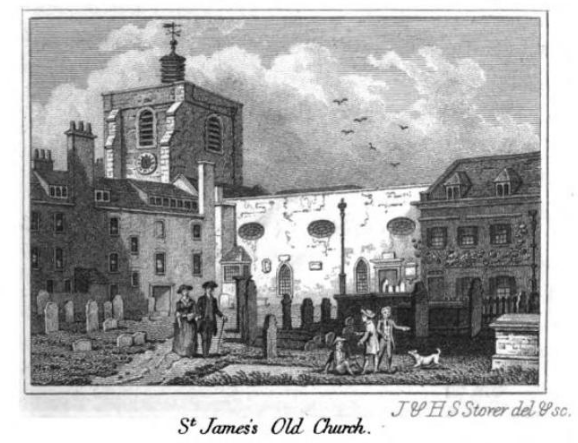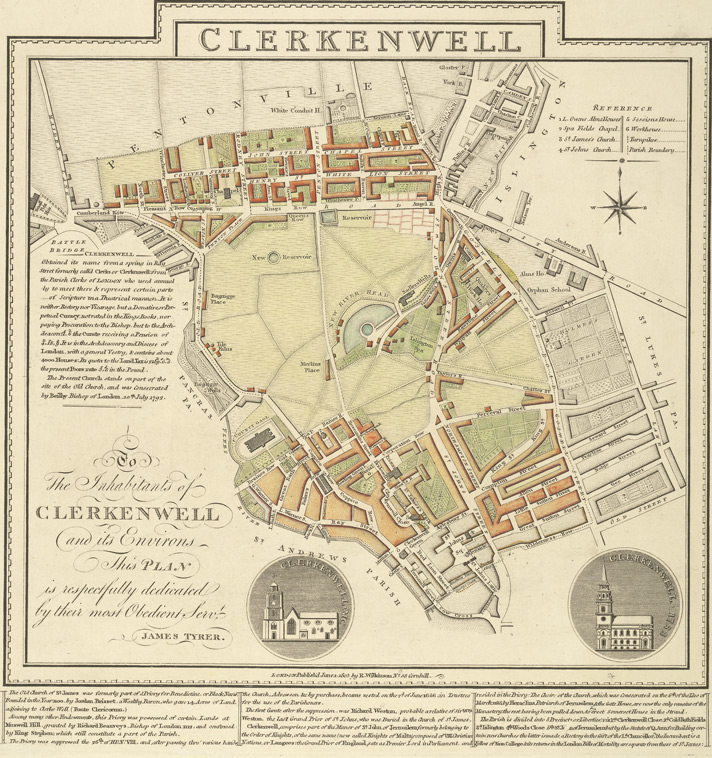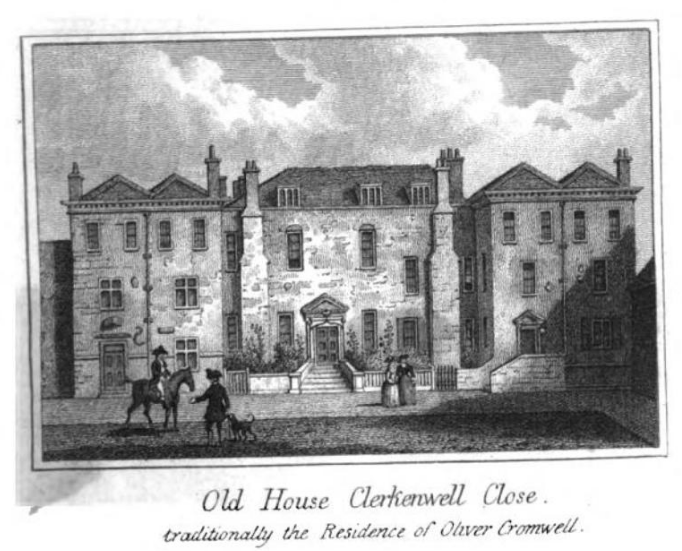MRP: House in St. John Street, Clerkenwell
Dallison house in St. John Street, Clerkenwell
Editorial history
26/12/11, CSG: Added hyperlinked Table of Contents
THIS ENTRY REQUIRES EDITING
Contents
Suggested links
See Places
See Bishop's Palace
Dallison family in Clerkenwell
The Dalyson family had a presence in St. James, Clerkenwell from quite early in the sixteenth century. There is some tentative evidence that the family had a house and property in the parish in that century, however, it is unclear how they used any building or buildings in Clerkenwell relative to their several homes in Lincolnshire. Given the strong legal tradition in the family, Clerkenwell may have been a convenient extramural Middlesex location for access to the law courts in Holborn.
Certainly a number of Dalysons, from both the Lincolnshire and the Kent arms of the family, were buried in the St. James, Clerkenwell parish church in the sixteenth and seventeenth centuries. On the Kent side they include William Dalyson, the grandfather of Elizabeth’s husband, Sir Maximilian Dalison, his son, and Elizabeth’s own husband. The elder William was buried in Clerkenwell in 1585, though his widow chose to be buried at Halling, beside her second husband, the senior Chancery lawyer William Lambarde. On the Lincolnshire side they include Edward Dalyson, son of Sir Roger Dalyson of Laughton, Lincolnshire, who was buried in Clerkenwell in 1624.
By the late 1620s it is clearly documented that Sir Maximilian Dalyson had a home in St. John’s Street, Clerkenwell, where his son William wooed Elizabeth from 1627 until his marriage in November 1631, as well as at Elizabeth's grandmother's house, also in St. John's Street. Sir Maximilian explicitly mentioned in his will, written in November 1630, “my house in St. John’s Street,” the contents and use of which he left to his second wife. But his wife died just two weeks after him. Sir Maximilian's step-brother and executor, Moulton (Multon) Lambarde recorded the deaths in his commonplace book. Both deaths took place at the St. John's Street house.
"1631 November 9. About 10 of the clocke in the forenoon my brother S:r Maximilian Dalyson Knight dep:ted this lyfe at his house in S:t Jhons Streete Midd. Anno D’ni 1631"[1]
"1631. November 24. At three of the clocke in the morning my sister the Lady Dalyson dep’ted this lyfe at her howse in S:t Jhons Street Middlesex."[2]
Sir Maximilian Dalyson continued the family tradition, requesting in his will "to be buried in the parish church of St. James Clerkenwell as neare the place where William Dallison (sic) Esquire my ffather, and Dame Paulina Dalison (sic) my first wife were buried."[3]
When the time came Elizabeth buried her own husband in Clerkenwell, and was herself interred there twenty-three years later, despite the strong desire of her brother Sir Henry Oxenden that she might be buried with her birth family at Deane. She was buried in the chauncel of the church, as recorded in the parish register.
Clerkenwell in 1620s and 1630s
Cromwell's History and Description of Clerkenwell (1828) characterised Clerkenwell in the mid sixteenth century as a relatively minor village, disagreeing with Maitland, who assumed, based on the parochial status of St. James, Clerkenwell, that it was a "considerable village." Examining the Aggas 'Civitas Londinium' plan and view of London of 1563 Cromwell noted that
"Clerkenwell, it is shewn by this plan, (with the exception of what buildings had been erected in the streets then, as now, called St. John's Street and Cow Cross), was little otherwise occupied than by the precincts and remains of the late monasteries. St. John Street itself was not more than a third part built, and the backs of the very few houses in Cow Cross...opened into fields."[4]
Considerable building took place between 1563 and 1598, when Stow characterised the area. Cromwell, quoting Stow, noted "many fair houses for gentleman and others are now built about this priory (the Nunnery) especially by the highway towards Islington."[5]
Cromwell used primary sources dating from 1619 and 1677 to characterise gentry and nobility in Clerkenwell in the early and later seventeenth century. Though the data are selective and not a robust profile it would be worthwhile to view these primary sources in the original. However, it is not clear that the 1619 parchment roll listing citizens of rank has survived (pp. 16-17). The 1677 source is reported by Cromwell to be an "old book, giving an official return of the residents, and their rents, anno 1677", which at the time was in the British Museum (p. 17). Though neither Dalyson nor Oxenden family names appear in the 1619 data cited by Cromwell, this could be due to his selectiveness with the data, incompleteness of the data, or because houses were rented not leased nor owned. The Dalyson family name (and variants) does not appear in 1666 hearth tax data for Clerkenwell.
Cromwell's History and description of Clerkenwell was accompanied by a number of engravings by J & HS Storer, which were linked to the text.[6] One engraving, reproduced below, was titled 'Antient houses St. John Street as they appeared 1811.' These houses appear to date from the first half of the seventeenth century, and, following Cromwell's text,[7] were on the west side of the lower end of St John Street, not that far above Hick's Hall, the Middlesex session house, which had been built in 1611, and before Wilderness Row. The text speculated that the houses at one time "formed one mansion with the Baptist's Head in St. John's Lane." The text noted that the houses suffered a fire in 1814 and were then removed. The houses are likely to have been on the section of St. John Street which appears on Strype's map of 'Cowcross, being S:t Sepulchre parish and the Charterhouse,' which shows Hicks Hall at the foot of St. John Street, with the Charterhouse just to the east. The houses were well to the south of the now Clerkenwell Road, which the text refers to as Old Street.[8]
The text also referred to Robert Seymour's Survey (1735), which included a description of St. John's Square.[9] An engraving by Hollar (1661) shows the remains of the Priory or Hospital of St. John on the square.[10]
The church of St. James, Clerkenwell, at the time of the Dalyson and Oxenden presence in St. John Street, was formerly dedicated to St. Mary and was the church of the Benedictine nunnery in Clerkenwell, which had been founded in circa 1100. The church was rededicated to St. James following the dissolution of the nunnery. It is in this rededicated church, which was removed and rebuilt between 1788 and 1792, that Elizabeth Dalyson, her husband, and many of his relatives were buried. Though a number of pre-1782 memorials are present in the church, a visit will be required to determine if there is any evidence of Dalyson burials
Further research required
- Examine maps of Clerkenwell from the first half of the C17th
- Look for contemporary descriptions of Clerkenwell in 1620s and 1630s
- Analyze hearth tax data for 1660s Clerkenwell to develop a social profile of the area during that period - Had it changed very significantly from the 1620s/1630s period? Was it affected by the development of Hatton Garden?
Images
Plan of Clerkenwell, 1805
Clerkenwell Close, 1828
Image credits
Tyrer, James, 'The inhabitants of Clerkenwell and its environs,' 1805
- Out of copyright image, sourced from Wikipedia article on 'Clerkenwell,' which sourced the image from Wikipedia Commons, a freely licensed media file repository
Storer, J & HS, 'Antient houses St. John Street as they appeared 1811' in Thomas Cromwell, History and description of the parish of Clerkenwell (London, 1828), opp. p. 112
- Out of copyright image sourced from an online edition of Cromwell (1828) with commons licence
Storer, J & HS, 'Old house Clerkenwell Close traditionally the residence of Oliver Cromwell ' in Thomas Cromwell, History and description of the parish of Clerkenwell (London, 1828), opp. p. 112
- Out of copyright image sourced from an online edition of Cromwell (1828) with commons licence
ADD IMAGE CREDIT FOR ST. JAMES OLD CHURCH
Sources used
- 'Alumni Oxonienses, 1500-1714: Dabbe-Dirkin', Alumni Oxonienses 1500-1714: Abannan-Kyte (1891), pp. 366-405
- Cromwell, Thomas, History and description of the parish of Clerkenwell (London, 1828)
Hasted, Edward,The History and Topographical Survey of the County of Kent: vol. 5 (1798), pp. 56-70
- Wikipedia entry, 'St. James's church, Clerkenwell'
- The Lambarde Diary, copied from from the original M.S. in the possession of Multon Lambarde, Esq., Beechmont’, in J.J.Howard (ed.), Miscellanea Genealogica et Heraldica (London, 1876), p. 103)
Potential primary sources
BHOL: Clerkenwell hearth taxes (1666)
London Metropolitan Archives; Saint James, Clerkenwell: Clerkenwell Green, Islington
Ratebook P76/JS1/85 1673
Register of Baptisms P76/JS1/1 Sep 1561-Jan 1653/4
- Not available for consultation: Printed Transcript with index available on microfilms XI02/029, XI02/032, XI02/033
Register of Marriages P76/JS1/2 Feb 1587/8-Jan 1653/4
- Not available for consultation: Printed Transcript with index available on microfilm XI02/032
Register of Burials and Marriages P76/JS1/3 Sep 1561 - Jul 1670
- Not available for consultation: Printed Transcript with index available on microfilms XI02/032, XI02/033
TNA
PROB 11/88 Drake 53-92 Will of The Right Honorable Lady Margaret Countess of Derby of Saint James Clerkenwell, Middlesex 12 November 1596
PROB 11/115 Wingfield 1-56 Will of Nowell Sotherton, Baron of the Kings Majesty's Exchequer of Saint Botolph without Aldersgate, City of London 24 May 1610
PROB 11/132 Meade 66-127 Will of Sir William Willoughby or Lord Willoughby of Parham, Suffolk 28 November 1618
PROB 11/136 Soame 65-120 Will of Sir Justinian Lewyn or Lewin of Otterden, Kent 11 July 1620
PROB 11/141 Swann 1-66 Will of Sir Thomas Cecyll or Cecill or Baron of Burghley and Earl of Exeter 11 March 1623
PROB 11/144 Byrde 66-118 Will of Sir Frauncis Lovell of Harling, Norfolk 12 November 1624
PROB 11/145 Clarke 1-63 Will of Sir Thomas Pelham of Laughton, Sussex 05 February 1625
PROB 11/155 Ridley 1-59 Will of Sir Frauncis Coningsbie or Coningsby of Wyddial, Hertfordshire 07 May 1629
PROB 11/157 Scroope 1-63 Will of Sir Anthony Barker of Sonning, Berkshire 15 April 1630
PROB 11/163 Russell 1-57 Will of Edward Lord Sturton of Stourton, Wiltshire 04 June 1633
Potential secondary sources
English Heritage's Survey of London, published in 2007, describes the architecture and buildings of Clerkenwell
Finsbury library contains the Islington local history centre
The majority of the St. James, Clerkenwell church registers and other parish documents going back to 1561, are kept at the London Metropolitan Archives, Northampton Road
G.E. Mitton, The facination of London:Clerkenwell & St. Luke's comprising the borough of Finsbury (London, 1906)
- ↑ 'The Lambarde Diary, copied from from the original M.S. in the possession of Multon Lambarde, Esq., Beechmont', in J.J.Howard (ed.), Miscellanea Genealogica et Heraldica (London, 1876), p. 103
- ↑ 'The Lambarde Diary, copied from from the original M.S. in the possession of Multon Lambarde, Esq., Beechmont', in J.J.Howard (ed.), Miscellanea Genealogica et Heraldica (London, 1876), p. 103
- ↑ Sir Maximilian Dallison will
- ↑ Thomas Cromwell, History and description of the parish of Clerkenwell (London, 1828), p. 14
- ↑ This is the footnote text
- ↑ Thomas Cromwell, History and description of the parish of Clerkenwell (London, 1828)
- ↑ Thomas Cromwell, History and description of the parish of Clerkenwell (London, 1828), pp. 113-114
- ↑ Thomas Cromwell, History and description of the parish of Clerkenwell (London, 1828), p. 118
- ↑ This is the footnote text
- ↑ This is the footnote text



